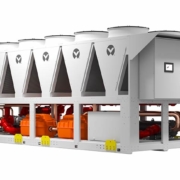Global warming is a reality for which we all must take responsibility. Our company manufactures chillers for refrigeration and air conditioning systems worldwide, so we are aware that some of the refrigerants we use in our systems – and their overall efficiency – can contribute to the problem. However, we are encouraged by the arrival of low-global-warming-potential (LGWP) technologies that address these environmental concerns. One such solution – HFO-1234ze – marketed by Honeywell under its Solstice® brand – is readily available.
HFO-1234ze has been a genuine breakthrough and we are now using it in many of our chillers. Non-ozone-depleting and mildly flammable, it has a LGWP of less than 1 and is safe for intended use. HFOs are highly efficient, which adds to its minimal warming profile with reduced indirect emissions, and has the potential to deliver significant cost savings. Another benefit is that this HFO uses the same technical footprint of its predecessor – the familiar HFC-134a – making it easy to incorporate into new chiller designs and reducing the training requirements for engineers and technicians.
Most of our customers use chillers within large infrastructure such as data centres, hotels, supermarkets, shopping centres, hospitals, production lines and manufacturing facilities. They tend to be part of responsible, multi-national organisations. The HFO platform is a welcome development; its advantages allow these customers to focus on innovations in other areas of their business and supports their corporate social responsibility efforts.
Although HFO refrigerants are perceived as “more costly” when compared with other refrigerants, the total cost of ownership of the chiller is lower over the 15 to 18 year lifecycle of the equipment. With Geoclima upgraded designs and the HFO-1234ze, many customers report a 20-25% reduction in their energy costs compared with their previous chillers.
Several measures focusing on energy efficiency and curbing carbon emissions have already started the chiller market in Europe, be it carbon taxation in several countries, Ecodesign Directive, F-gas Regulation or building codes. F-gas Regulation limits the amount of traditional high GWP refrigerants put on European market and therefore driving the market to use products with lower GWP. Ecodesign Directive puts a lot of focus on increasing minimum performance requirements of chillers with the aim to eliminate low performing chillers. Chillers using HFOs help manufacturers achieve the performance required by the directive.
We at Geoclima introduced the first HFO-1234ze chiller back in 2011 and plan to switch our full production to HFO refrigerants within the next four years. We are convinced HFOs represent the best mix of performance, safety, cost and environmental benefits.
Despite the enthusiasm we see for HFO-based chillers, there remain some unconvinced by the technology. Many companies still gravitate toward the lowest priced chiller option, and there are plenty of budget solutions to cater to their needs. Unfortunately, their short-term gain will lead to long-term pain, as it is a matter of when – not if – the energy efficiency requirements and the CO2 equivalent quota reduction of the phase-down scheme under the F-gas Regulation will lead to a non-gain business with the traditional solutions.
That said, the adoption of the existing environmental legislation and reinforcement by the Member States is disconcertingly slow, and sometimes unclear. One reason for its unhurried progression, we suspect, is the lack of market education about LGWP technologies, which is also inhibiting the development and delivery of components to support LGWP systems. We take low GWP as a fundamental factor in the refrigerant choice and would prefer the regulations for this kind of applications to be stricter – and much faster. In Switzerland, for instance, for our chillers in installations of 400kW or more, we see a regulation mandating use of refrigerants with GWP lower than 10.
While we as Geoclima have a solid regional coverage in Europe, U.S. represents a new focus area for us, especially in high energy efficient chillers. In the U.S., the lack of market awareness of chillers with LGWP refrigerants is even more apparent and a lot of work needs to be done so that users understand their benefits.
Reducing energy cost for the end users of chillers is a big part of the equation. However, having a sense of social responsibility is also important. That’s why we need to do everything we can to protect the environment for future generations. Chiller manufacturers – and the broader industrial sector – must coalesce to raise awareness of LGWP and energy efficiency, and create a supply chain to support it. We need to break down remaining silos of resistance and support legislators and government bodies to help comply with the regulations. Despite the complex challenges that lie ahead, the business and ethical case for LGWP solutions such as HFO is well worth the effort.







